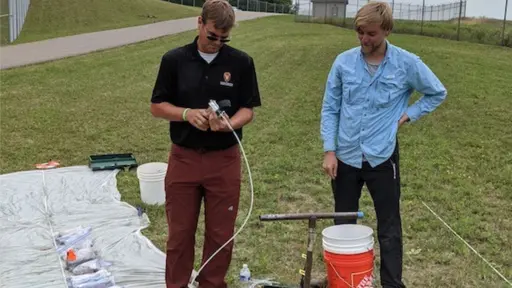The city of Rhinelander in northern Wisconsin has dangerous “forever chemicals” in its water. In fact, in 2019, the city shut down two of its water wells after it found per- and polyfluoroalkyl substances (PFAS) levels well above state regulations for safe drinking water.
James Tinjum, an associate professor of civil and environmental engineering at the University of Wisconsin–Madison, is helping the city understand where those chemicals originated and what to do about them.
 CEE Associate Professor Jim Tinjum, left, talks to graduate student Elliot Draxler during field work in Rhinelander. Tinjum and Draxler were collecting groundwater samples using a suction lysimeter near the Rhinelander-Oneida County Airport.
CEE Associate Professor Jim Tinjum, left, talks to graduate student Elliot Draxler during field work in Rhinelander. Tinjum and Draxler were collecting groundwater samples using a suction lysimeter near the Rhinelander-Oneida County Airport.
PFAS chemicals, according to the Centers for Disease Control Agency for Toxic Substances, may interfere with the human body’s natural hormones, increase cholesterol, adversely affect the immune system and increase the risk of some cancers. PFAS are in the blood of 99 percent of Americans and have been found in water in cities across the United States. The chemicals are specifically designed not to break down under harsh conditions—but that also means that when they get into the environment, they linger.
“You can imagine if they tend not to degrade, they’re going to last a very long time,” Tinjum says. “The problems we’re seeing in Rhinelander and other places may have been there for decades.”
Soon after shutting down the two wells, Rhinelander Mayor Christopher Frederickson contacted Tinjum to enlist his aid. Tinjum says he’d started working more closely with PFAS about a year prior, and had implemented lessons about the chemical family into his landfill design short course and remediation geotechnics class at UW–Madison.
“This all started with outreach from the mayor when he was looking for independent scientific research and guidance to help with the PFAS issue,” Tinjum says. “I had a familiarity with the chemicals, this opportunity with the city allowed us to set up a field site through which we could prepare and submit proposals and start on field-oriented research on the nature, fate and transport of PFAS in the environment.”
Tinjum joined the city’s PFAS task force, Water Action Team Rhinelander (WATR), and led an effort to create a white paper on PFAS chemicals that’s now on the city’s website. His colleague Dante Fratta, who heads the Wisconsin Geotechnics Laboratory, helped lead a geophysical field investigation near the wellfield, while Tinjum led efforts to sample water and in around the closed city of Rhinelander Landfill. Tinjum also received funding from the Wisconsin Alumni Research Foundation (WARF) for exploratory work to characterize the area around the Rhinelander-Oneida County Airport. He’s working with Fratta, an associate professor of civil and environmental engineering, and Christopher Zahasky, an assistant professor of geoscience, on that effort.
The team went to Rhinelander in July 2021 to conduct field testing using a variety of tools, including ground-penetrating radar—which works like weather radar pointed at the ground to observe soil conditions, locate the water table, and search for changes in the area’s general geological profile.
“The ground-penetrating radar is a shallow technique,” he says. “It only goes about 10 meters or so down. Some of the seismic tools we have available can look deeper. Using those, we can see that at about 40 meters below the ground’s surface, we have what appears to be a bedrock valley that we think may be funneling some of the groundwater.”
It’s important to understand the underground features, because they may tell the story of how PFAS-contaminated water moves from its source—whether that’s from the airport, landfill or somewhere else—to mix with water that feeds city wells.
“This is providing us with intelligence so that when we go into the next phase of field investigation, we know where it’s most beneficial to take soil or groundwater samples,” Tinjum says. “Ultimately, with that chemical information, we hope to be in a position to provide the city and its engineers with concepts on how to remediate these issues.”
Though the project is still ongoing, Tinjum says a few potential solutions have come into view. In one solution, the wells would be reactivated, with granular-activated carbon filtration systems that can remove dangerous chemicals from water before it’s distributed to homes and businesses. Another solution may involve heating the soil to a high temperature—more than 650 degrees Fahrenheit—to release and or destroy the chemicals. In that scenario, a plastic barrier would be placed over the soil to capture and safely remove any chemicals that aren’t destroyed in the heating process.
The work is an example of the Wisconsin Idea—the idea that research and knowledge developed at UW–Madison should be shared for the benefit of the state and the world—in action. In this case, Rhinelander is just one beneficiary among many other communities such as Eau Claire and La Crosse that also are facing their own PFAS challenges.
“Without question, we’re taking the Wisconsin Idea and putting it into play,” Tinjum says. “We’re taking our expertise on campus and using it for the public good. This is starting with Rhinelander, but other municipal leaders may be able to use similar technologies while they work through their issues.”